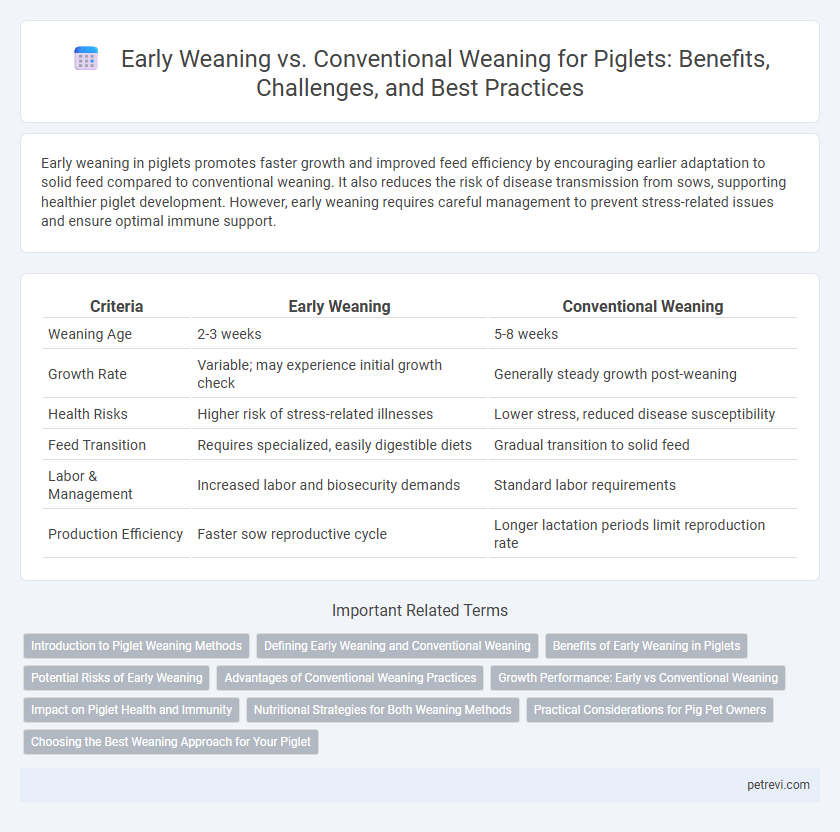Early weaning in piglets promotes faster growth and improved feed efficiency by encouraging earlier adaptation to solid feed compared to conventional weaning. It also reduces the risk of disease transmission from sows, supporting healthier piglet development. However, early weaning requires careful management to prevent stress-related issues and ensure optimal immune support.
Table of Comparison
| Criteria | Early Weaning | Conventional Weaning |
|---|---|---|
| Weaning Age | 2-3 weeks | 5-8 weeks |
| Growth Rate | Variable; may experience initial growth check | Generally steady growth post-weaning |
| Health Risks | Higher risk of stress-related illnesses | Lower stress, reduced disease susceptibility |
| Feed Transition | Requires specialized, easily digestible diets | Gradual transition to solid feed |
| Labor & Management | Increased labor and biosecurity demands | Standard labor requirements |
| Production Efficiency | Faster sow reproductive cycle | Longer lactation periods limit reproduction rate |
Introduction to Piglet Weaning Methods
Early weaning in piglets typically occurs at 14 to 21 days, promoting faster sow reproduction cycles and enhanced piglet growth through specialized diets, while conventional weaning happens around 28 days. This method contrasts in stress levels and gut development, as early weaning requires careful management of nutrition and environment to support immune function. Understanding these differences is essential for optimizing piglet health, growth performance, and overall productivity in swine production systems.
Defining Early Weaning and Conventional Weaning
Early weaning in piglets typically occurs at 14 to 21 days of age, significantly earlier than conventional weaning, which usually happens around 28 to 35 days. Early weaning aims to enhance sow productivity and reduce the risk of disease transmission by shortening the lactation period. Conventional weaning allows piglets extended access to sow's milk, promoting gradual digestive development and stronger immune system maturation.
Benefits of Early Weaning in Piglets
Early weaning in piglets accelerates their growth by promoting earlier adaptation to solid feed, enhancing nutrient absorption and digestive enzyme activity. This method reduces the sow's reproductive interval, increasing the number of litters per year and improving overall farm productivity. Early weaning also minimizes disease transmission risks associated with prolonged contact between piglets and sows.
Potential Risks of Early Weaning
Early weaning in piglets can lead to increased susceptibility to gastrointestinal disorders such as post-weaning diarrhea due to abrupt dietary and environmental changes. Reduced immune function and heightened stress levels contribute to higher mortality rates and impaired growth performance compared to conventional weaning methods. Potential risks also include longer recovery periods and increased veterinary costs caused by weakened gut integrity and microbial imbalances.
Advantages of Conventional Weaning Practices
Conventional weaning practices in piglets promote gradual dietary transition, reducing stress and supporting stable gut development essential for nutrient absorption. This method enhances immune system strength by allowing prolonged maternal antibody transfer, decreasing susceptibility to common post-weaning diseases. Furthermore, conventional weaning fosters improved growth rates and feed efficiency, contributing to overall better productivity in swine operations.
Growth Performance: Early vs Conventional Weaning
Early weaning in piglets generally leads to a temporary reduction in growth performance due to stress and dietary adjustments, but can promote better feed efficiency post-weaning compared to conventional weaning. Conventional weaning around 21-28 days supports more stable initial growth, as piglets remain with the sow longer, reducing weaning-associated stress and digestive challenges. Optimal growth performance depends on balancing early nutritional management and immune support to mitigate early weaning drawbacks.
Impact on Piglet Health and Immunity
Early weaning in piglets often leads to increased stress, resulting in compromised gut integrity and heightened susceptibility to infections compared to conventional weaning. Conventional weaning typically supports better immune system development due to prolonged access to maternal antibodies and nutrient-rich sow's milk. Studies indicate that piglets weaned later exhibit improved growth rates, reduced morbidity, and enhanced immune responses, highlighting the critical role of weaning age in piglet health management.
Nutritional Strategies for Both Weaning Methods
Early weaning in piglets requires tailored nutritional strategies emphasizing highly digestible protein sources, elevated energy density, and immunomodulatory additives such as prebiotics and probiotics to support gut development and immune function. Conventional weaning allows gradual dietary transitions, enabling piglets to adapt to solid feed with emphasis on balanced amino acid profiles and fiber inclusion to promote gut health and feed efficiency. Both methods benefit from phase feeding programs that adjust nutrient density according to piglet growth stages, optimizing post-weaning performance and minimizing stress-related growth setbacks.
Practical Considerations for Pig Pet Owners
Early weaning of piglets typically occurs at 2 to 3 weeks of age, influencing nutritional requirements and increasing the need for specialized milk replacers to ensure proper growth and immune support. Conventional weaning, generally at 6 to 8 weeks, allows piglets more time to develop natural immunity and consume sow's milk, reducing stress-related health issues. Pig pet owners must balance early nutritional interventions and environmental enrichment to minimize weaning stress and promote optimal development.
Choosing the Best Weaning Approach for Your Piglet
Early weaning piglets between 14 to 21 days can promote faster reproductive cycles for sows and reduce disease transmission but requires carefully managed nutrition and housing to prevent growth setbacks. Conventional weaning at 28 days or later supports stronger immune development and better digestive adaptation, leading to improved piglet health and reduced mortality rates. Selecting the best weaning approach depends on balancing farm management capabilities, piglet health status, and long-term production goals.
Early weaning vs Conventional weaning for Piglets Infographic

 petrevi.com
petrevi.com